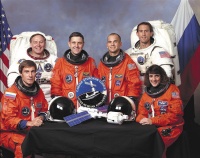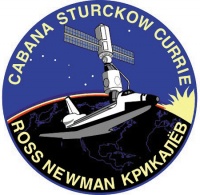STS-88
From The Space Library
 | |
| Organization | NASA-Office of Space Flight (United States) |
|---|---|
| Mission type | Human Crew |
| Launch date | December 4, 1998 |
| Launch vehicle | Space Shuttle |
| Launch site | Cape Canaveral, United States |
| COSPAR ID | 1998-069A |
| Inclination | 51.6 degrees |
| Experiments | Here |
| Alternate Names | 25549 |
| Additional Information | Here |
| Telecommunications Information | Here |
| Data Collection | Here |
| Payload Mass Up | 14055.01 kg |
| Payload Mass Down | 2045.45 kg |
| Orbiter | Endeavour |
| Lift Off Mass | 2,053,813.64 kg |
| Orbiter Weight at Liftoff | 119,966.82 kg |
| Orbiter Weight at Landing | 91,043.64 kg |
| Landed | Concrete runway 15 at Kennedy Space Center, Fla. |
| Orbits of Earth | 186 |
| Orbital Altitude | 173 nautical miles (199 statute miles) |
Contents |
[edit] Crew
- Commander: Robert D. Cabana
- Pilot: Frederick W. "Rick" Sturckow
- Payload Commander:
- Mission Specialist 1: Nancy J. Currie
- Mission Specialist 2: Jerry L. Ross
- Mission Specialist 3: James H. Newman
- Mission Specialist 4: Sergei Konstantinovich Krikalev, Russian Space Agency
[edit] Mission
STS 88 is an American shuttle spacecraft. It carried Unity (also known as Node 1) module for the International Space Station (ISS), two minisatellites (SAC-A and Mightysat 1) for a later day ejection, and some other experimental items of interest to K-14 level students. The shuttle crew (of six) hoisted the Unity module over the open cargo bay on 05 December and positioned it perpendicular to the shuttle. Thrusters were then fired to black flip the shuttle and reach ISS-Zarya within 3 m when the robotic arm of the shuttle captured Zarya (that was below STS) on 06 December. Zarya's and Unity's ports were then aligned with a separation of only a few centimeters when the shuttle's thrusters fired again to dovetail them tight. After several days of extravehicular activities (EVAs) to secure the joints, and interconnect the power lines and computer links and, after raising the shuttle's altitude by about 10 km, the joined modules were released from the shuttle for free flight on 13 December 1998.
[edit] EVA
Extravehicular Activity (EVA) conducted by Jerry Ross and James Newman during three spacewalks for a total of 21 hours, 22 minutes. EVA 1, Ross and Newman, 7 hours, 21 minutes; Ross and New-man made all umbilical connections necessary to activate Node 1. Upon completion, the ground sent commands to the node to confirm power and activation. EVA 2, Ross and Newman, 7 hours, 2 minutes; Ross and Newman installed EVA translation aids and tools and early communications system antennas and routed the communication cable from the FGB to the starboard antenna. EVA 3, Ross and Newman, 6 hours, 59 minutes; EVA 3 was performed to support objectives of downstream assembly missions. Tasks included installation of a large tool bag for storing EVA tools outside the station and repositioning foot restraints. Additionally, Ross and Newman disconnected the umbilical on PMA-2 so that PMA-2 can be relocated in the future.
[edit] Payload
ISS Unity connecting module; IMAX cargo bay camera (ICBC); Satelite de Aplicaciones/Cientifico A (SAC-A); MightySat 1; Space Experiment Module (SEM) 07; Getaway Special G-093
[edit] Books about the Space Shuttle Program
Buy This Book Click here |
Buy This Book here |
Buy This Book Click here |
Buy This Book Click here |





